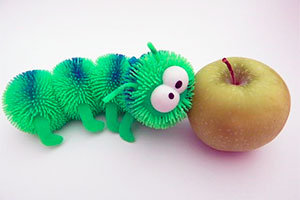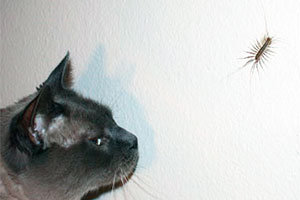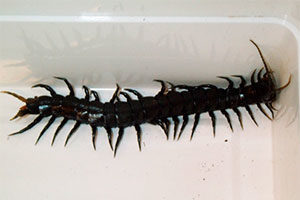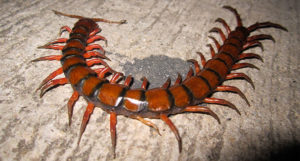You may be wondering why you are seeing so many centipedes darting around your home. “Where did they come from and why are they here?, ” you may be asking yourself. “What is attracting them, and how did they get in?”
The best way to prevent a centipede infestation or to formulate a strategy to eradicate centipedes from your home, is to learn the facts about “the enemy” so you can “fight smart, not hard.” Continue reading to “get the scoop on” these 30-legged pests that are stepping all over “your turf.”
Click on the link to learn the answer to the commonly asked question, “What is the difference between a centipede and a millipede?”
[toc]
Why do I have centipedes in my house?
The reasons you are seeing centipedes in your house are much the same as for other pests: they come seeking food, water, warmth, shelter, and a place to lay their eggs and start up a whole new generation of “30-legged freaks.”
Where do you typically find centipedes in your home?
Any of these locations are a common place to spot them:
- In bath tubs,
- In sinks,
- In drain pipes,
- In sump pump hoses,
- In bathrooms and kitchens,
- In basements and crawl spaces.
Any moist, shady environment will do. And sometimes, centipedes will even trap themselves in tubs and sinks, which is lucky for you since it makes it easier to target them with pesticides!
Note that centipedes will wander in looking for prey to feed on, which will normally be other small insects and spiders. And they frequently show up during the hottest and driest periods of the year.
An air conditioned house with plenty of water and bugs to eat is too much for them to resist!
Where do they come from?
If you have centipedes in yours house, rest assured you also have them out in your yard. And, as there are thousands of species of centipedes dwelling in a wide range of climate-types, you likely live in a region that centipedes call home.
 More specifically, centipedes in the wild live in moist dirt, leaf piles, and in dead trees or logs. Their contribution to the ecosystem is immense, being (as they are) some of the largest invertebrate predators on the planet.
More specifically, centipedes in the wild live in moist dirt, leaf piles, and in dead trees or logs. Their contribution to the ecosystem is immense, being (as they are) some of the largest invertebrate predators on the planet.
But that doesn’t mean you want them to be part of your “in-house ecosystem.”
Another way to answer the question, “Where do centipedes come from?” is to say that they hatch out of eggs laid in damp soil in the spring or summer. Each mother centipede will lay 30 or more eggs at a time. The larvae will emerge from the eggs, and then progress through six distinct life stages.
Did you know that centipedes are hatched with only 4 pairs of legs but can ultimately reach from 15 to over 150 pairs? And even though “centipede” comes from the Latin words for “hundred legs, ” centipedes normally have an odd number of leg-pairs (thus, there may not be a centipede on earth with exactly 100 legs!).
What causes centipedes to enter my house?
The main cause of centipedes entering your house is that they cannot remain outdoors in extreme conditions without being in danger of drying out and dying.
Centipedes do not have the waxy protective “cuticle” covering that many other insects and spiders possess. This means that they rapidly dehydrate and must seek out places with plenty of moisture.
Heat will also, of course, speed up the dehydration process and drive hoards of thirsty centipedes into your house.
What are house centipedes attracted to?
A second reason centipedes enter a building is that they are attracted to other pests already in it. What prey especially draws them in?
 Here is a basic “centipede menu”:
Here is a basic “centipede menu”:
- Crickets,
- Spiders,
- Roaches,
- Earwigs,
- Silverfish,
- Pantry Moths,
- Flies.
But almost any small bug will do. Centipedes rush their victims and grab onto them with their two front legs, which contain a venomous substance that is fatal to other insects but (in the common house centipede at least) not too dangerous to humans.
Click on the link to learn the true answer to the pressing question, “Do centipedes bite?”
How do they get in my house?
Outside, centipedes may live in your firewood supply and hitchhike a ride into your home when you bring wood inside for your wood stove or chimney.
 Centipedes may also linger and lurk about under piles of leaves you rake up and don’t immediately dispose of or burn. Put that pile too near your house, and it could be a centipede magnet.
Centipedes may also linger and lurk about under piles of leaves you rake up and don’t immediately dispose of or burn. Put that pile too near your house, and it could be a centipede magnet.
Rocky crevices near your home also invite centipedes, and once living in those rocks, they can crawl in through cracks in your home’s foundation.
If you have a dead, rotten tree near your home or a tree with thick, grooved bark, that can also bring them near the house and lead to an infestation.
Unlike many other household pests, centipedes leave no clear signs of an infestation other then actually catching sight of them. They prowl about rather than make nests, and you won’t be able to see their feces or urine. They don’t feed on your food supplies, so that’s not a clue. But see one scurry up the wall or down the drain, and you can assume where there’s one there’s more than one!
Centipedes also make their way into your house by crawling up drain pipes and sump pump hoses. And they are not shy about sneaking in through the gap under the front door or through gaps in your windows either.
Stop Attracting Centipedes and Get Rid of The Ones You Have
The first step in protecting your home from centipedes is to simply clean up your yard (remove clutter, leaves, and dead wood) and be careful when bringing in firewood or anything that’s been outside.

Next, you need to seal off cracks in your foundation and other likely entry points. You will also need to reduce moisture levels in problem areas, and if you can increase lighting too, that will also help.
Click the link to learn all about the best centipede repellent options.
Here are the main tricks to centipede control:
- If you spot a centipede, kill it! Often, there are only a small number of centipedes in your home and a kill on sight policy does the trick.
- Cover basement drains with a screen cover since that is a prime way centipedes get into your house.
- Use boric acide or diatomaceous earth to “poison the soil” in key centipede traffic zones.
- Use a pyrethrin fog/spray to kill centipedes on contact.
- Put pesticide powder (designed for centipedes) into cracks in concrete, dark corners, and other spots where centipedes are fond of “hiding out.” But you can’t use baits as such since this particular pest seeks after only living, moving prey.
- Create a barrier around your house by heavily dousing the soil in a “wall” of poisoned dirt.
- Spray your yard, including grass, greenscape, hardscape, and garden.
Finally, you can use “sticky traps” to catch both centipedes and their prey. Place the traps in corners, along walls, and behind furniture.
Once you identify what your centipedes are feeding on, invest in pest management measures against those other insects infesting your home. That will both rid your premises of a number of unwanted guests and cut off the food supply of centipedes, forcing them to forage elsewhere or starve to death.
In sum, centipedes are a nuisance in many homes in the U.S., startling unsuspecting residents and threatening a possible bite if handled or threatened.
Centipedes like moist, dark, cool crevices and shelters to live in. They retreat into (invade) your home when conditions outside threaten to dehydrate them or come in search of other insects that may already be infesting you home.
There are many strategies you can resort to in trying to cease attracting centipedes or to find and kill those already inside your house. But when DIY methods fail, do not hesitate to contact a pest management professional with expertise in centipede extermination.




Ever since I bought a foam mattress topper, I have an infestation of centipedes. Do foam mattress toppers attract them and how do I get rid of them as a DIY method